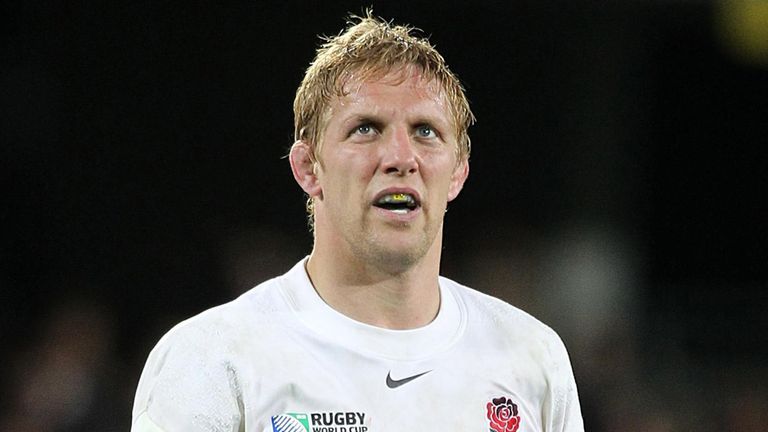Rugby Legend Lewis Moody Reveals His Battle with Motor Neuron Disease: Fans Show Unwavering Support

In October 2025, the rugby world was shaken by a revelation few saw coming. Lewis Moody, former England captain, World Cup winner, and beloved figure in the sport, stepped forward with news that would not only test his personal strength but also galvanize support across the global rugby community. Moody disclosed that he has been diagnosed with motor neuron disease (MND), known more familiarly in some contexts as amyotrophic lateral sclerosis (ALS). The disclosure sent waves of shock, empathy, and determination through fans, former teammates, and the wider public alike — a story of courage in the face of adversity, and of how sport’s greatest figures sometimes face its toughest battles off the field.
1. From “Mad Dog” to Mentor: The Legacy of Lewis Moody
To understand the impact of Moody’s announcement, one must first understand the man. Born in 1978 in Leicester, Moody’s playing career would come to define a certain kind of fearless rugby. He earned the nickname “Mad Dog” for his relentless work rate, combative defense, and voracious appetite for contact. Over the course of his professional career, he amassed 71 caps for England, captained his nation on several occasions, and played a key role in the 2003 Rugby World Cup triumph. At club level, his heart belonged to Leicester Tigers, where he was integral to multiple Premiership titles and European campaigns. He later spent time at Bath before retiring in 2012.
Beyond his on-field exploits, Moody and his wife Annie founded The Lewis Moody Foundation (established in 2014), focusing primarily on aiding families affected by brain tumours, raising awareness, and supporting research. The foundation has been a visible embodiment of Moody’s desire to give back. Thus, his MND diagnosis would mark not just a change in his personal life, but a dramatic new chapter in his public and philanthropic identity.
2. The Diagnosis: A Moment of Shock and Resolve
2.1 The Initial Warning Signs
According to Moody, the first inkling something was amiss came during gym sessions. He began to notice oddness in his shoulder and hand — a subtle muscle wasting that he initially dismissed. Physiotherapy provided no relief, prompting further investigation. These symptoms, while modest and early, are typical of how motor neuron disease often begins — creeping and gradual, sometimes too subtle to raise red flags immediately.
Roughly two weeks before the public announcement, scans revealed damage to the nerves in his brain and spinal cord consistent with ALS / MND. At 47 years old, Moody publicly confirmed the diagnosis on 6 October 2025, calling it “a huge shock to me and my family.”
2.2 Moody’s Reaction: Fear, Acceptance, and Positivity
In his statement, Moody was candid about the psychological turbulence. He admitted there is “a reluctance to look the future in the face” at present. Yet he emphasized that he feels “fit and well” in himself for now, and remains committed to “staying positive, living life, and dealing with the changes I will experience as they come.”
Describing his symptoms as “very minor,” he expressed a desire to continue fulfilling roles in his life — whether personal, philanthropic, or public — for as long as possible. Moody emphasized gratitude for the support of family, friends, and medical professionals, and asked for space as he and his loved ones process the diagnosis.
It is telling that even in the face of a terminal diagnosis, Moody’s first instincts were not despair but resolve — to fight, to adapt, and to continue making meaning through service and connection.
3. Understanding Motor Neuron Disease (MND / ALS)
To fully appreciate the gravity of Moody’s situation, one must understand what motor neuron disease entails — its effects, prognosis, and current state of research.
3.1 What is MND / ALS?
Motor neuron disease refers to a group of rare neurological disorders in which the motor neurons — the nerve cells that control muscles — progressively degenerate, leading to muscle weakness, atrophy, and ultimately loss of voluntary movement. In many countries, ALS (amyotrophic lateral sclerosis) is the most common subtype of MND.
As motor neurons die, the brain’s capacity to send signals to muscles diminishes, impairing abilities such as walking, speaking, swallowing, and breathing. In advanced stages, respiratory failure is often the cause of death. The disease typically progresses over months to years; the speed of progression varies greatly from person to person.
3.2 Early Symptoms and Diagnosis
Early signs of MND can be subtle: weakness or stiffness in a limb, slurred speech, difficulties swallowing, muscle cramps or twitching (fasciculations), weight loss, or a weak grip. Because the onset is gradual and varied, diagnosis is often delayed or misattributed to other conditions.
Diagnosis typically involves a battery of tests — neurological exams, electromyography (EMG), nerve conduction studies, MRI scans, and ruling out other diseases.
3.3 Treatment, Prognosis, and Research
As of now, there is no cure for MND. However, treatments exist to manage symptoms, slow progression slightly, and improve quality of life. These can include:
- Medications such as riluzole or edaravone in some countries, which modestly slow neurodegeneration
- Physical therapy, occupational therapy, speech therapy
- Assistive technologies (mobility aids, communication devices)
- Respiratory support and palliative care when required
Prognosis is highly variable. Many people survive 2–5 years after onset, but some live significantly longer. The late physicist Stephen Hawking is a well-known example of long survival, though his form of MND had atypical progression.
Research in this field is active but challenging. Because MND is relatively rare, with varied presentations and rapid progression, understanding its causes (genetic, environmental, traumatic) remains a work in progress. There is also ongoing debate about whether repeated head injuries or concussions — common in collision sports like rugby — may increase risk, though causation has not been definitively established.
Some studies suggest that former rugby players may have a higher incidence of neurodegenerative disease: for example, a 2022 study showing ex-internationals had more than twice the risk of neurodegenerative conditions and 15 times higher risk of MND compared to matched controls. Nonetheless, as analysts caution, correlation is not causation; many questions remain unanswered.
4. The Rugby Community Responds: Solidarity in Action
Moody’s announcement evoked an immediate outpouring of support from across rugby and sports more broadly. The response illustrates how this disease, tragic though personal, has become a rallying cry within the sporting world.
4.1 Tributes, Messages, and Institutional Support
Governing bodies were swift to express solidarity. The Rugby Football Union (RFU) offered heartfelt condolences, emphasizing Moody’s contributions on and off the field and pledging support for him and his family. Bill Sweeney, RFU’s CEO, described Moody as “one of the toughest and most fearless players ever” and noted the organization’s commitment to offer “emotional and practical support” in whatever form is needed.
Former England teammates and rugby legends also weighed in. Will Greenwood recalled Moody’s dual nature — a fierce competitor on the field, but a deeply optimistic, giving person off it. “He will fight this with every ounce of his strength,” Greenwood said. Legendary coach and fundraiser Kevin Sinfield, whose efforts in memory of MND-suffering friend Rob Burrow have raised millions, pledged support: “We have to keep fighting MND together.”
Other former players diagnosed with MND, like Ed Slater, voiced their sympathy and pledged standing in solidarity. Former teammates Geordan Murphy and Leon Lloyd launched a GoFundMe campaign shortly after Moody’s announcement, hitting over £30,000 in donations within hours.
4.2 Fan Reactions, Media Coverage, and Public Outpouring
Fans took to social media almost immediately, expressing shock, love, and admiration. Hash-tags such as #StayStrongMadDog, #SupportMoody, and #MNDAwareness trended among rugby circles. Many shared video compilations of Moody’s career highlights: bone-crushing tackles, relentless breakdown work, and moments of leadership.
Media outlets ran heartfelt tributes, feature pieces, and analysis. The Guardian ran an article titled “Rugby world rallies round former England captain Lewis Moody,” exploring not just the emotions of the moment but also the broader context of MND in rugby. Other outlets detailed Moody’s career, the mechanics of MND, and comparisons to previous rugby figures who suffered similar fates.
Notably, the public response also included calls for broader awareness and increased funding into MND research. In many postings and comments, fans linked Moody’s case with earlier figures like Doddie Weir (Scotland), Rob Burrow (rugby league), and Joost van der Westhuizen (South Africa), reminding the public that this is not an isolated tragedy but part of a pattern that deserves urgent attention.
4.3 Fundraising, Foundations, and Future Campaigns
The GoFundMe set up by Murphy, Lloyd, and others was intended initially to assist Moody’s family and health needs, as well as to support MND-related causes. Within hours it raised tens of thousands of pounds, signaling the readiness of the rugby community to mobilize.
Moody, for his part, expressed a desire to expand his philanthropic work. He stated his intention to continue The Lewis Moody Foundation’s work, and to create an opportunity to support a charity “closer to my current situation.”
It is likely that Moody’s diagnosis will catalyze further fundraising drives, collaborative campaigns, and research initiatives — particularly as other prominent rugby names and existing MND-focused entities join the cause. Indeed, existing campaigns led by Sinfield and others may see renewed vigor in light of Moody’s story.
5. The Broader Context: Rugby, Neurodegeneration, and Accountability
Moody’s diagnosis cannot be viewed in isolation; it emerges in a context where the sport of rugby has faced increasing scrutiny over neurological risk, injury protocols, and long-term athlete welfare.
5.1 Patterns of MND in Rugby
Over recent decades, several high-profile rugby figures have been diagnosed with MND or similar conditions:
- Doddie Weir, Scotland international, diagnosed in 2016 and died in 2022.
- Rob Burrow, rugby league legend, diagnosed in 2019, died in 2024.
- Joost van der Westhuizen, former Springbok scrum-half, diagnosed in 2011, died in 2017.
- Ed Slater, former Gloucester player, continues to live with a diagnosis.
These cases have raised the question: is elite rugby inherently riskier for neurodegeneration? Some epidemiological studies suggest elevated risk among former international contact-sport athletes, but the evidence remains mixed and inconclusive. As Andy Bull of The Guardian notes, “everyone wants answers … and unfortunately, they are very hard to come by.”
5.2 Concussion, Head Trauma, and Uncertain Links
One focal point is concussion and repeated sub-concussive blows. Rugby, as a high-impact sport, inevitably involves collisions, tackles, and rucks — all of which can transmit force to the brain and spine. Some researchers posit that cumulative microtrauma could contribute to neurodegenerative processes, potentially including MND.
However, the challenge is proving cause-effect. Many factors may interplay: genetics, environment, metabolic stress, exposure to chemicals, high-intensity training, and more. The MND Association itself emphasizes that the correlation between trauma and MND remains unproven and that current data are inconclusive.
5.3 Responsibilities of Governing Bodies and Future Safeguards
In light of such diagnoses, calls have grown louder for rugby authorities (international unions, club leagues) to adopt stronger safety protocols, better head injury assessments, and more stringent long-term health monitoring for athletes. Some propose changes such as reducing contact training, enhanced concussion protocols, regular neurological screenings, and better support for retired players.
Moody himself has not publicly joined legal actions against rugby bodies, unlike some peers. He has expressed discomfort with attributing blame and seems determined instead to work within the system to raise awareness and advocate for change. That stance is consistent with Moody’s broader ethos: he seldom courts controversy, preferring to adapt and foster positive influence from within.
6. The Personal Battle: Family, Identity, and the Unknown
It is important to remember that behind the headlines this is first and foremost a deeply personal journey. Moody and his loved ones now face a transformation in daily life, identity, and expectations.
6.1 The Role of Family and Support Structures
Moody is married to Annie, an interior designer, and the couple have two sons. In his public statement, Moody acknowledged the vital role his family — especially Annie — will play in the days ahead. He asked for space to navigate this news privately, signaling that the emotional processing is still unfolding.
Chronic, life-shortening diseases of this kind often shift roles within family systems. The spouse may become caregiver, a child may confront existential fears, and the diagnosed person must balance hope, dignity, vulnerability, and dependence. These realities do not diminish one’s identity — Moody will remain “Lewis Moody” — but they complicate it.
6.2 Wrestling with Identity and Purpose
Athletes often form their identity around physical prowess, competitive drive, and performance. The onset of a degenerative disease challenges that identity at its core. For Moody, whose life has long been defined by action, resilience, and giving, the diagnosis forces recalibration: What is meaningful when the body is less cooperative? How to channel ambition when outcomes are uncertain?
Yet Moody has already signaled his intention to continue contributing — through his foundation, through advocacy, and through the relationships and persona he has earned. In doing so, he may serve as a model not merely of physical toughness, but of psychological grace and adaptability.
6.3 The Uncertain Future: Fear, Hope, and Acceptance
One of the cruellest aspects of MND is its unpredictability. While patterns exist, the course is never fully foreseeable. That uncertainty can breed fear — not only of physical decline but of loss of autonomy, communication, and dignity. For Moody, the psychological dimension is as significant as the physical. He has admitted that, at this stage, he is not ready to fully face what lies ahead.
Yet there is also space for hope — hope in medical innovation, in supportive care, in moments of connection, and in the possibility that the disease’s worst advances may be delayed. The outpouring of support, fundraising, and research attention gives reason to believe that Moody’s journey, while deeply challenging, will not be traversed alone.
7. What This Means for MND Awareness and Legacy
Moody’s announcement is not just a personal turning point; it has broader implications. It may catalyze increased public awareness, funding, and efforts to understand the disease — and it may further pressure sports institutions to confront the health risks their players face.
7.1 Fueling Awareness and Research
High-profile diagnoses, especially of beloved figures, often galvanize public attention and funding. Moody’s stature ensures that the spotlight on MND will expand. The narrative will shift from tragedy to purpose, from personal struggle to shared responsibility.
Already, fundraisers and campaigns are clustering around his name. The GoFundMe by his former teammates is a start; long-term initiatives will likely follow. Moody’s own foundation has the infrastructure to pivot toward MND support and research, should he choose.
7.2 Pressuring Institutional Change
Every major revelation like this heightens scrutiny on institutions: governing bodies, clubs, medical committees, and sports science departments. The public, media, and athletes will increasingly ask: Were risks sufficiently explained? Were safety protocols strong enough? Are former players adequately monitored and supported?
Moody’s own history gives weight to these questions — having been an insider, a respected voice, and someone who balances loyalty to the sport with humility. If he chooses to advocate for changes, his voice will carry both authority and moral force.
7.3 Inspiring Others by Example
Perhaps Moody’s greatest legacy in this chapter will be the example he provides: that vulnerability does not negate courage, that suffering does not erase purpose, and that even in decline, one can extend meaning, generosity, and connection.
For fans, young athletes, and former players, his journey may prompt deeper reflection about health, identity, and what sport asks of bodies. In that regard, Moody’s story — already legendary — may offer lessons far beyond his playing days.
8. Conclusion: A Legend Faces a Hardest Match
Lewis Moody has spent a lifetime confronting formidable opponents — fast forwards, heavy tackles, fatigue, injuries. Yet the challenge posed by motor neuron disease is unlike any he has had to face before. It is slower, more insidious, and intimate in its assault.
And yet, in his initial statements, he refused to cede agency. He affirmed his intention to live fully, to lean on support, and to continue contributing in whatever capacity he can. The rugby world, in response, has rallied — not in passive sympathy but in active solidarity: fundraising, tributes, awareness campaigns, and existential reflection on the responsibilities of sport.
This is not a story of defeat. It is, rather, a story of transformation — of how a warrior may be challenged not on a pitch, but within their own body, and how the truest measure of strength may lie in adapting, advocating, and sustaining connection even when options narrow.
As fans, we do well to stand by him — not simply in sentiment, but in supporting research, listening to voices of lived experience, and demanding better protections for every athlete, past and present. Moody’s battle is deeply personal, but it invites us all to reflect — on mortality, on how we treat those afflicted by disease, and on how sport and society might better safeguard its heroes beyond the glory of victory.
In Lewis Moody’s own words: “I feel your love and support … I will continue to embrace life and grasp opportunities in the same way I always have.”




